| [Home] | [Locations] | [Blog] | [Photostream] | [Links] | [About] | [Extras] | [Contact] | [Donate] |


Update: Sunday February 16, 2025
It's wild to think that at one point in time, suburban Wayne New Jersey was once home to three separate inclosed and indoor shopping malls. The largest of the three malls being Willowbrook Mall, which is currently a thriving shopping metropolis located within a flood plain in the southernmost section of Wayne Township. Just across the street from Willowbrook Mall used to sit the Wayne Towne Center, another inclosed shopping mall, up until it was de-malled in 2008 and today only exists as a strip mall. However, last but not least was the Wayne Hills Mall, yet another small inclosed shopping mall located in the more northern Wayne Hills section of Wayne Township. It's difficult to decipher if the Wayne Hills Mall was ever a thriving mall, especially since it always existed within the shadows of the Willowbrook Mall located just a few miles south. However, despite the Wayne Hills Mall small size, it did home a number of noteworthy stores from Walden Books to Sam Goody, a McDonalds and some smaller mom-and-pop stores. The Wayne Hills Mall eventually closed for good in 2015 and was subsequently demolished in 2019. Today a huge ShopRite grocery store sits in the original footprint of the mall. The original Burlington Coat Factory anchor store building to the mall still exists as of 2025 but it is closed and the Burlington Coat Factory moved across the street into a building that used to be a Toys R. Us and then sat vacant for many years.
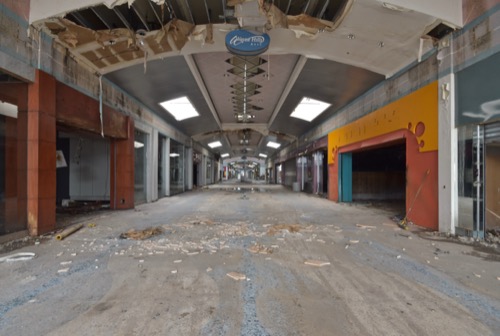 |
Update: Monday April 1, 2024
Amboy Cinemas was one of those ruins that seemed to hide in plane sight. Located mere feet from three major highways in urban Middlesex County NJ, the condemned movieplex seemed to go unnoticed for years, despite being abandoned for well over a decade. I myself had driven past the vacant theater certainly hundreds of times before I ever really considered it as a potential explore. It wasn't until I saw a random YouTube video about the old theater pop-up online that my curiosity was even piqued. In hindsight I'm glad I took some time to look around inside. For what Amboy Cinemas lacked in charm it made up for in iconicness, as potentially the most driven past New Jersey ruin.
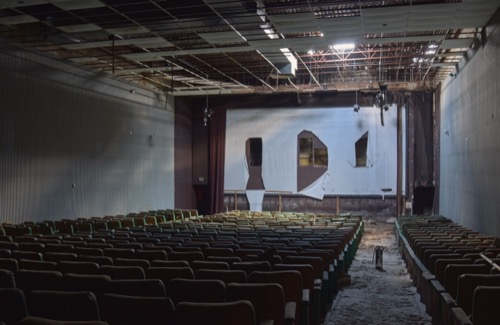 |
Update: Monday May 1, 2023
Situated at the beginning of a dead-end road on the outskirts of East Stroudsburg, Pennsylvania, the hulking remains of the International Boiler Works rot. The Boiler Works is one of those iconic ruins that seems to have stood the test of time and is more notable perhaps in its state of abandonment than when it was an active factory, producing boilers. Over the decades since its closing, the factory has been host to numerous parties and consequently, it has suffered through numerous fires, its steel skeleton always impervious to the flames. Over the years the property has become a dumping ground for all things discardable, both human and material. Homeless call the vast empty warehouse home nearly as often as locals party it up inside the vast space. Years worth of graffiti ranging from teenage scribble to artistic pieces decorate the sheet metal walls. The smooth concrete floor, a perfect place to erect a fire pit, as evidenced by ashes encircled within brick rings. I can not say the International Boiler Works was a special place per-say, photogenic if only because of its state of anarchy, yet the boiler works was certainly a iconic place. I say "was" because time has finally stopped ticking for the trashed factory. As of Spring 2023 demolition has begun and while I don't think many will miss the buildings, it is for certain the lawless fun they hosted over so many decades will be longed.
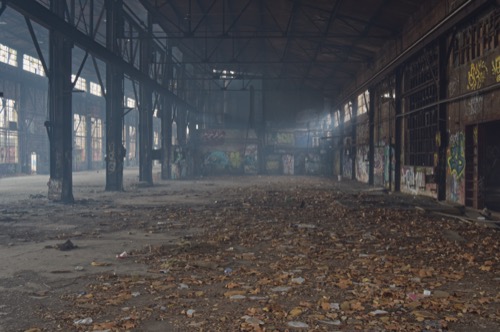 |
Blog Update: Monday March 28, 2022
On satellite view the abundant anthracite strip-mines of Northeastern Pennsylvania appear like a giant scar across the Earth. The major cities significant of the Northern, Middle, and Southern coalfields are easy to spot, however an elaborate network of long abandoned underground mine workings remain below the surface, invisible to the eye...
 |
Blog Update: Sunday January 23, 2022
The blasted open Administration Building is one of the few remaining hospital structures left standing within a wide open brownfield strewn with manmade detritus including bricks and chunks of concrete. Divots in the ground highlight where magnificent buildings one stood and re-bar protruding from hunks of cement poke up through the soil providing visual clues to where the labyrinth of steam tunnels once snaked below...
 |
Update: Monday April 12, 2021
Most people probably associate Harriman State Park in New York with its dozens of lakes, numerous historic camping shelters, and hundreds of miles of hiking trails, which is indeed alluring for any outdoors enthusiast. However, Harriman State Park also holds secrets to a handful of far more interesting treasures. From dozens of abandoned iron mines to a junkyard full with classic 1950s automobiles. There's so much to be discovered off the beaten paths which zigzag all throughout the expansive 47,527 acre property. You never know what you may stumble upon if you stray from the marked trails. The Harriman State Park Junkyard, as I've deemed it, was a particularly interesting find. The numerous abandoned cars all scattered about the mountain side raised an abundance of questions in my mind. It seems almost impossible that such vehicles could have even wound up here in the first place. With the nearest road being miles away and no sign of any long forgotten woods roads, it was almost as if the automobiles fell from the sky one stormy day and landed quite literally in the middle of the woods. I've been back this particular junkyard a handful of times, but no visit was quite as wonderful as the time I visited during peak fall foliage. The way the rusted cars popped against the backdrop of vibrant yellow, red, and orange leaves was truly an incredible sight. I haven't been back to the Harriman State Park Junkyard in many years, and my memory is even a little fuzzy on where exactly it is. I've also never been able to find any history nor stories explaining its existence. And to this day it still remains a mystery as to how all these classics were just dumped off the side of a steep cliff, left to rot for eternity somewhere deep in the woods.
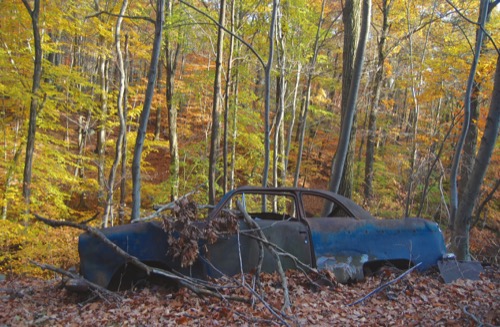 |
Update: Tuesday December 8, 2020
Hidden within the sprawling cornfields of Northwest New Jersey, an industrial gem rotted for decades. Nestled just across the Musconetcong River, the dividing line between Warren and Hunterdon Counties, the only obvious clue as to the mill's existence was a corroded water tower which for nearly a century awkwardly overlooked row after row of nauseating corn and soy bean fields. Sometimes the most unsuspecting of locations hide the most interesting of ruins, as is the case with the Hughesville Paper Mill, one of the few remaining relics from Hunterdon County's industrial paper making past. During the early 1900s numerous paper manufacturing mills were erected along side the many tributaries snaking their way toward the mighty Delaware River. The largest of such mills, the Curtis Paper Mill, was only recently completely demolished in late 2019 despite the shocking news about a young woman having fallen to her death from a catwalk, three years prior. The Hughesville Paper Mill also met its fate in late 2019, for today just an empty field remains. The Hughesville Mill, while undoubtedly the smallest of the many mills was perhaps the most interesting. Ancient machines and paper presses were left behind within their original positions, still dripping oil and chemicals is if they could be started back up at any time. With the completion of demolition of the Hughesville Mill, the physical history of the Northern NJ industrial paper making process will be nearly completely destroyed; only the empty swaths of polluted brown fields remain as visual scars hinting at the areas once industrious past.
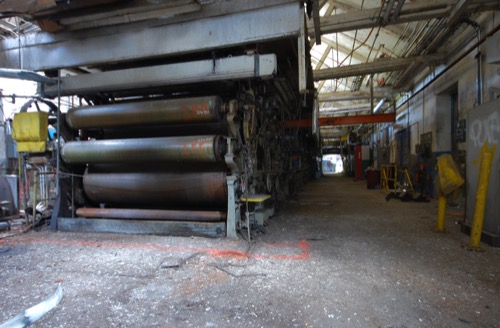 |
Blog Update: Saturday August 29, 2020
The advancement of technology and the ability to rapidly communicate brought with it the initial promise of unifying ideas, shared values, and core freedoms in the hope of spreading a sense of democracy world wide. However, upon examining current culture, it appears that technology has evolved faster than our menial biological brains could keep up...
 |






